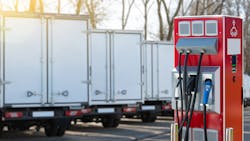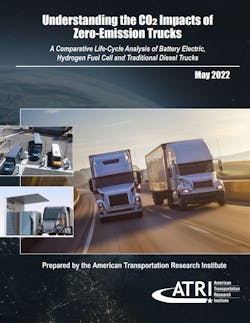ATRI study offers warnings on electric Class 8s
Just-released findings from the American Transportation Research Institute (ATRI) put a spotlight on Class 8 battery-electric trucks, pointing out the higher current prices to purchase the heavy electric vehicles (EVs) and the environmental costs to manufacture them, generate and deliver their power, and produce their batteries.
The study does conclude that production and use of heavy EVs—which have no tailpipe emissions themselves—results in a 30% decrease in CO2 emissions when compared to traditional diesel-burning commercial vehicles. But a summary released with the study terms these benefits as “marginal”—when carbon-burning processes that are required to get EVs made and moving are factored into their total value to the industry.
See also: Southeast carrier gathering real-world Class 8 EV data
EVs of every class are regarded by many stakeholders as the future of freight transportation, even as diesel-burning trucks have decades left to serve freight transportation. Trucks other than Class 8s make up 42% of all U.S. commercial vehicles while heavy-duty tractors cover 58%, according to FleetOwner’s own Trucking by the Numbers. One organization, the North American Council for Freight Efficiency (NACFE), identified lighter delivery vans recently as 100% electrifiable.
That research notes the widely known range limitations of electric Class 8s (150 to 250 miles, depending on conditions), their much higher purchase cost ($400,000 to $600,000, depending on configuration, compared to a conventional diesel truck, which can run around $150,000), and their greater weight and reduced space available for freight to be hauled. “They’re not going to be a panacea for the industry,” Murray said of Class 8 EVs.
He continued: “If you can imagine the driver shortage now, imagine stopping the driver every 150 miles. If we don’t get something close to [the range] of a diesel, we’re going to have issues.”
He also noted that the fleets will be shocked how much their terminals with a full bank of chargers for EVs will tax the electric grid.
Murray conceded, however, that electric Class 8s might one day be more capable but could be a “steppingstone” for other over-the-road options that are friendlier to total cost of ownership, chiefly hydrogen electric fuel-cell tractors, as ATRI's study contends. “Hydrogen is exciting,” he added.
So, Murray said, is renewable diesel (RD), which isn't a fossil fuel and burns much cleaner than convention diesel but can be used in engines that use conventional distillate. But RD is imported, not widely available, and almost exclusively used in California due to the state’s Low Carbon Fuel Standard.
See also: Electrification at a 'tipping point' as fleets explore adoption
The new ATRI research concludes that hydrogen fuel cells also are the most environmentally friendly type of commercial truck. Hydrogen fuel cells don’t draw power from batteries but instead use onboard fuel cells, which are filled with hydrogen almost as quickly (less than 5 minutes) and easily (through a nozzle at a pump) as diesel-burning commercial vehicles.
The study also spends much of its 43 pages on the environmental drawbacks of electric Class 8 tractors as well as their problematic total value for fleets to operate.
“This research provides industry, government, and other stakeholders with a technical environmental impact assessment of switching to [zero-emission trucks] as well as a glimpse at the advancements that may be needed to further decrease industry emissions,” the study states.
For the environmental downsides of Class 8 EVs, the ATRI research points to production of their lithium-ion batteries, which the study concludes generate six times more carbon than manufacturing an entire diesel-burning Class 8 truck.
The research, according to an ATRI summary released with the study, relies on work by the Argonne National Laboratory, the Lemont, Illinois-based U.S. Department of Energy research center, and the lab’s Greenhouse Gases, Regulated Emissions, and Energy Use (GREET) Model, and factors in CO2 emissions from the burning of fossil fuels to produce power for the U.S. electrical grid.
See also: Fleet electrification: Go or no-go for launch?
“The U.S. trucking industry is strongly committed to carbon-reduction efforts, and electric motors and drive trains offer many additional performance and maintenance benefits,” Hugh Ekberg, president and CEO of CRST, a large Cedar Rapids, Iowa-based over-the-road fleet, said in the release that accompanied the study. “But ATRI’s research highlights that several of the leading zero-emission approaches being advocated today still need additional research to fully understand how the different technologies can be best developed and utilized to maximize carbon reduction.”
The ATRI research identifies additional strategies that can reduce CO2 truck emissions for all three energy sources—diesel, electric, and hydrogen. Renewable diesel fuel could decrease carbon emissions to only 32.7% of a diesel engine without requiring the new trucks or infrastructure that electric and hydrogen requires, the study notes. It also concludes that hydrogen sourced from solar-power electricity could enable HFCs to emit only 8.8% of the CO2 of a diesel-burning truck.
According to one source cited in the ATRI study, by the end of 2021 there were 1,215 zero-emission trucks deployed in the U.S., the majority of which were battery electrics. Of these, the report states that 47 were classified as heavy-duty trucks, though this figure has grown this year. This stands in contrast, according to the research, to the 23 million Classes 2 through 8 trucks on U.S. roads that have internal combustion engines.
The ATRI study also even points to the sourcing of materials for batteries—lithium, graphite, cobalt, and nickel—the costs and CO2 emissions required to produce them, and the recycling needed to dispose of degraded truck batteries. The research even takes a look at how long the batteries of electric vehicles take to degrade and the conditions—weather and temperatures included—that are factors.
The study concludes by saying: “This research documents ... that the trucking industry can decrease CO2 emissions through a variety of vehicle types. The key finding of this report is that zero-emission trucks still generate significant CO2 emissions and will continue to have CO2 emissions in the coming decades.”
About the Author
Scott Achelpohl
Managing Editor
Scott Achelpohl is a former FleetOwner managing editor who wrote for the publication from 2021 to 2023. Since 2023, he has served as managing editor of Endeavor Business Media's Smart Industry, a FleetOwner affiliate.


